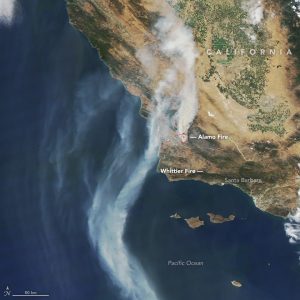
On July 8, 2017, the Moderate Resolution Imaging Spectroradiometer (MODIS) on NASA's Aqua satellite captured this image of smoke streaming from the Alamo fire. (Credit: NASA image by Jeff Schmaltz, LANCE/EOSDIS Rapid Response)
In July 2017, sweltering temperatures and strong winds fueled intense wildfires in southern California. The fires forced thousands of people to flee their homes, charred dozens of structures, closed roads and darkened skies throughout the region with thick smoke.
Through July 10, 2017, the Alamo fire had charred roughly 30,000 acres (100 square kilometers) in San Luis Obispo County. Meanwhile, the Whittier fire, near Cachuma Lake (Santa Barbara County) had scorched 10,000 acres.
Countervailing winds at different levels of the atmosphere pushed smoke plumes from the Alamo fire in opposing directions. As the fire grew in intensity, more smoke billowed higher into the atmosphere, where the mid-levels winds began to push it northward.
According to National Interagency Fire Center statistics, 3.1 million acres of wildfires have burned in the United States between Jan. 1, 2017 and July 7, 2017, above the average of 2.4 million acres for the last 10 years.

